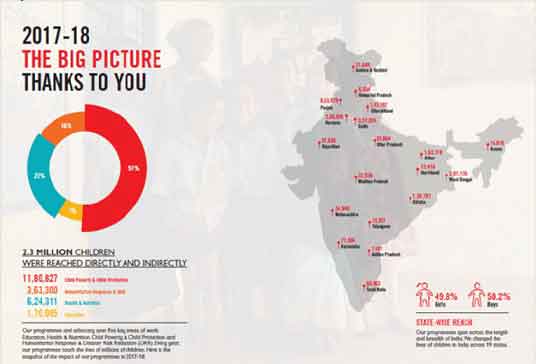Role of NGO In Rehabilitation of Juveniles
Types of Juveniles
There are two types of Juveniles under the Act.
1. 1. Child in need of care and protection;
2. 2. Delinquent Child.
The term child in need of care and protection is described under sub-section
14 of section 2 of the Juvenile Justice (Care and Protection of children) Act,
2015.
According to ‘Google’ juvenile means “for or relating to young people, Childish
or immature”.
And the term Delinquent Child or Juvenile Delinquency, according
to Black’s Law Dictionary means, The wrong doing of youth or children.
And under the Act it is referred to as a Delinquent Child.
Role of NGO’s in Rehabilitation of Juveniles
As we all know that Adolescence is that period where a child is filled with
enormous confusions, and they are not able to differentiate between right and
wrong. At this stage they are like a piece of clay to which their behavior, the
society, the the neighborhood, the friends and family, the teachers or any other
person with whom the child interacts, plays an important role in order to mold
one’s character from bad to good or vice-versa. It’s a time filled with rage and
impulse. The National Crime Record Bureau’s (NCRB) data shows that there has
been a the rampant increase in crime rate for juveniles.
There are many NGO’s in India as well as in the state of J&K, which are
currently working for the rehabilitation of the Juveniles, in the state or in
the country.
Save the Children
If we look at the ‘Our Projects’ section in “Save the Children’s” official
website, it says that they are most of the time asked about, why people should
donate to Save the Children and what is the impact which it is making in
reality?
Then they say that they have a list of some key programmes which they are
currently running. The NGO has an ‘area-driven’ approach. Through the support of
the donors, they are running 59 programmes in 19 states of India.
It was only possible through the help of these donors that ‘Save the Children’
has changed the lives of more than 1 crore Indian children since 2008.
They mainly focus on five thematic areas:
Ø Child Protection;
Ø Health & Nutrition;
Ø Education;
Ø Humanitarian Response & Disaster Risk Reduction
Ø Child Poverty.
This five-fold programmes are not only reducing the possibilities of the child
delinquency or feasibility of adult criminals but are in actual sense rehabbing
the juveniles or for that matter rehabbing ‘the child in need of care and
protection’.
As Dr. Seuss once said, “Adults are just outdated children.” So the children
need the care, protection, and rehabilitation.
Nelson Mandela said There can be no keener revelation of a society’s soul than
the way in which it treats its children.

In the above picture, it is visible, that the work of this NGO in rehabbing the
Juveniles around the country have been way more helping. And the data in this
picture only marks the work done in the year 2017-18. This NGO has done a very
good job in the rehabilitation of the Juveniles in the past as well. This
picture actually shows that this NGO reached to 2.3 Million children directly or
indirectly. By focusing on the cause of child delinquency, like Poverty,
Education, Humanitarian Response & Disaster Risk Reduction (DRR), Health and
Nutrition, they are evicting the future criminal or ‘delinquent child’, along
with which they are also rehabbing the ‘child in need of care & protection’.

Building Kareena into a Leader from ‘A Girl Next Door’
Rabindranath Tagore said Every child comes with the message that God is not yet
discouraged of man.
Kareena, a 14-year-old girl having ambitions to do something in her life, to do
something for her family, to work for her society, was told to lend a helping
hand and contribute towards her family income by which there came a standstill
on her education. This NGO identified her case and made her a member of the
Children’s group in her community. She participated in many programmes and
training on child rights on state-level. These training immensely helped her.
Today she is a flag-bearer of the campaign against the malpractice of child
labour in tea estates.
This is just one story from their countless number of achievements, which they
have provided to the nation. There lay many more stories of success.
By these services, they are not only protecting or rehabbing the children’s but
they are actually securing and protecting the future of this nation. They
focused on safeguarding the rights of children in Assam. They also addressed the
social evil which is still prevailing in our society like child marriage.
Mahatma Gandhi said: If we are to teach real peace in this world, and if we are
to carry on a real war against war, we shall have to begin with the children.
This NGO is also working on reducing the child mortality rate. Along with which
they are also addressing the child malnutrition in the first 1000 days after the
child is born.
Mother Teresa said “It’s the greatest poverty to decide that a child must die so
that you may live as you wish.”
It was nearly impossible for my little child Nikhat to survive without Save the
Children’s support – Gulnaz Shiekh, Mumbai.
And this is not the only case, there are number of other examples of the same
nature, where this NGO came forward and helped the children. This programme has
reached around 30,000 beneficiaries in the Shivaji Nagar area of Mumbai.
Taking education to the doorsteps of children:
Save the Children’s project ‘Quality education for drop out and irregular
children from urban slums and squatter colonies in Kolkata’ reaches out to
children in the age group of 3 to 10 years (pre-primary and primary sections).
They work in close coordination with stakeholders like Department of Education,
Sarva Shiksha Mission, Kolkata Primary School Council and other policymakers to
advocate for and implement the Right to Education Act in full force.
Learning through technology:
Using Information Communication Technology, Save the Children undertook an
initiative to improve the quality of education for underprivileged children at
10 Government Primary Schools of Haveli District, Pune. This project has helped
more than 1,500 students and 80 teachers.
Oscar Wilde said: The best way to make children good is to make them happy.
There are many more NGO’s out there to work for children. Like;
1. Child Rights and You (CRY).
They are working since 1970 for child welfare, helping to educate them,
eradicate child labour and child abuse.
2. Katha.
It provides quality education to underprivileged children.
3. Smile Foundation.
This organisation works for education, healthcare and livelihood.
4. Childline India Foundation.
It is India’s first free emergency phone service for children in need of aid and
assistance.
Conclusion
These NGO are working tirelessly, day and night, 24x7 for those children who are
in need of care and protection or the delinquent child. They work for the
betterment of these children from the time they are born and continue to help
and support them, whether economically, educationally, and socially or in terms
of health care facilities. By this way, they reduce the possibilities of child
delinquency. These NGO’s play a vital and essential role in betterment and
rehabilitation of children; because when a person has a better present he has a
better future. These NGO’s are eviting the child delinquency by implementing
these programmes.
Mahatma Gandhi said: The future depends on what you do today.
Law Article in India
Lawyers in India - Search By City
Popular Articles
How To File For Mutual Divorce In Delhi
How To File For Mutual Divorce In Delhi Mutual Consent Divorce is the Simplest Way to Obtain a D...
Increased Age For Girls Marriage
It is hoped that the Prohibition of Child Marriage (Amendment) Bill, 2021, which intends to inc...
Facade of Social Media
One may very easily get absorbed in the lives of others as one scrolls through a Facebook news ...
Section 482 CrPc - Quashing Of FIR: Guid...
The Inherent power under Section 482 in The Code Of Criminal Procedure, 1973 (37th Chapter of t...

Home | Lawyers | Events | Editorial Team | Privacy Policy | Terms of Use | Law Books | RSS Feeds | Contact Us
Legal Service India.com is Copyrighted under the Registrar of Copyright Act (Govt of India) © 2000-2025
ISBN No: 978-81-928510-0-6


Please Drop Your Comments